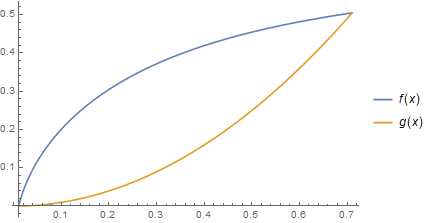The answer is no. Indeed, if this conjecture were true, then the conditions $f(a)=g(a)$, $f(b)=g(b)$, and \begin{equation} k_f(x):=\frac{|f''(x)|}{(1+f'(x)^2)^{3/2}}=k_g(x) \end{equation} for all $x \in [a, b]$ would imply that \begin{equation} \ell_f:=\int_a^b\sqrt{1+f'(x)^2}\,dx=\ell_g; \end{equation} that is, we would have that the length of the graph of a smooth enough function $f$ over $[a,b]$ would be determined by the curvature of the graph and the values of $f$ at $a,b$.
Let us show that this is not so. Indeed, let \begin{equation} h(x):=\frac12 \sqrt{\frac{(1+4 x^2)^{3/2}-3 x-8 x^3}{x+3 x^3}}. \end{equation} Everywhere here $x>0$, unless otherwise specified. It is not hard to see that the expression under the square root is $>0$, so that the definition of $h$ is correct. Let now \begin{equation} f(x):=\int_a^x h(u)\,du \end{equation} and \begin{equation} g(x):=x^2-a^2, \end{equation} where $a:=1/100$. Then \begin{equation} \frac{f''(x)}{(1+f'(x)^2)^{3/2}}=\frac{-2}{(1+4x^2)^{3/2}}=-\frac{g''(x)}{(1+g'(x)^2)^{3/2}}. \end{equation} So, the function $f$ is concave, the function $g$ is convex, $f(a)=g(a)$, and \begin{equation} k_f=k_g. \end{equation} Moreover, $f'(a)>g'(a)$. So, there is a unique real $b>a$ such that $f(b)=g(b)$; in fact, $b=0.710526\ldots\;$. However, \begin{equation} \ell_f=0.920463\ldots\ne0.894858\ldots=\ell_g, \end{equation} which does disprove the conjecture.
This counterexample is illustrated here:

